This essay was originally published in The Public Domain Review under a Creative Commons License. Please see their rules for reuse.
When birds of paradise first arrived to Europe, as dried specimens with legs and wings removed, they were seen in almost mythical terms — as angelic beings forever airborne, nourished by dew and the “nectar” of sunlight. Natalie Lawrence looks at how European naturalists of the 16th and 17th centuries attempted to make sense of these entirely novel and exotic creatures from the East.

In 1522, the dismembered skins of new and fabulous creatures were brought to the court of Emperor Charles V of Spain. These were birds of paradise from the East Indies, carried with a cargo of spices and other valuable marvels on the last remaining ship from a fleet that had left in 1519 to circumnavigate the globe under Ferdinand Magellan. These birds were unknown and entirely unseen in Europe, but they caused an instant stir. The ship’s chronicler, Antonio Pigafetta, described how five of these enigmatic objects were presented to the Spanish sailors by a Moluccan Sultan as a royal gift for the Emperor:
These birds are as large as thrushes; they have small heads, long beaks, legs slender like a writing pen, and a span in length; they have no wings, but instead of them long feathers of different colours, like plumes… they never fly, except when the wind blows. They told us that these birds come from the terrestrial Paradise, and they call them ‘bolon dinata‘, that is, “divine birds”.1
These unusual skins were shrunken and wingless, causing their beaks and gorgeous plumes to be disproportionately exaggerated. They were prepared by New Guinean hunters for tribal dances and displays, which still occur in tribal areas of New Guinea. The flesh and limbs were removed, though methods varied by tribe and species of bird, and the whole skin was smoked to heighten the dramatic effect of the elaborate feathers.
Yet the living birds were virtually unknown to anyone outside New Guinea, even to the Moluccan traders who dealt in New Guinean products. One Portuguese apothecary who travelled around Southeast Asia wrote in 1513 that birds “which are prized more than any others come from the islands called Aru (Daru), birds which they bring over dead, called birds of paradise (pasaros de Deus)”. Bird of paradise plumes, in particular, were some of the most coveted products in Asia and had been part of Asian trade networks, which circulated spices and other valuable goods such as ivory and textiles, for at least 5000 years before Europeans reached the region in the late fifteenth century.
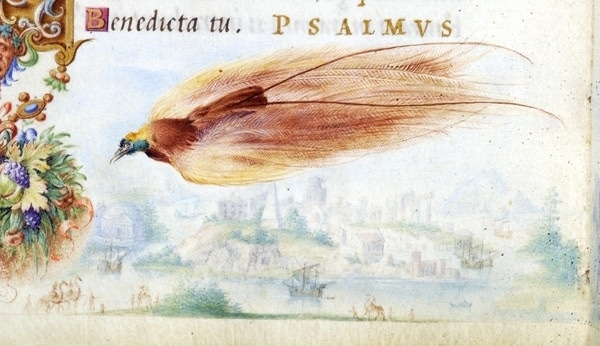
Spices such as cinnamon, cloves, and nutmeg grew only in the Moluccas, but reached the Middle East and eventually Europe in the Middle Ages through trade networks that passed through Venice. Before the sixteenth century, however, nothing was known of the birds of paradise in Europe. It was this high demand for spices in early modern Europe that drove the first European explorations of “a strange, and for so many ages, an unknown world, in order to search for the islands where spices grow”, and, more importantly, to profitably undercut the Venetian monopoly.
Spanish court secretary Maximilianus Transylvanus wrote an account of Magellan’s travels, De Moluccis Insulis (1523), constructed from interviews with sailors. It included Islamic Asian myths transported to Europe along with the skins:
The kings of Marmin began to believe that souls were immortal a few years ago, induced by no other argument than that they saw that a certain most beautiful small bird never rested upon the ground nor upon anything that grew upon it; but they sometimes saw it fall dead upon the ground from the sky. And as the Mahometans, who travelled to those parts for commercial purposes, told them that this bird was born in Paradise, and that Paradise was the abode of the souls of those who had died, these kings embraced the sect of Mahomet, because it promised wonderful things concerning the abode of souls. But they call the bird Mamuco Diata [Bird of God]…2
Accompanied by such fabulous accounts, these striking objects could hardly fail to become something special. In the 1540s, more bird of paradise skins began to trickle into Europe from Portuguese and Spanish trading vessels returning from the East Indies. The skins, most of which bore the iridescent green and velvet brown plumage of the greater bird of paradise (Paradisaea apoda), were prepared for trade, limbs removed, and rapidly acquired by aristocratic collectors for their curiosity collections.

There were still a relatively small number of specimens scattered in a variety of collections across Europe. Apart from the collections of the Cardinal of Salzburg and Charles V in Spain, the German humanist Conrad Peutinger owned a specimen, as did the Italian scholar Julius Caesar Scaliger. The apothecary-collector Francesco Calzolari in Verona had a specimen of a chamaeleon aereus described in his collection catalogue, and the German physician-botanist Melchior Weiland had acquired a specimen during his travels in the Levant. The skins fetched painfully high prices on the open market: a 1550 pamphlet from Nuremberg advertised a skin of the birds known to the Greeks as “apodes” (“without feet”), on sale for the price of 800 thalers, equivalent to a year’s salary for a university scholar or skilled musician.

Very little was published about these rare birds until the middle of the sixteenth century. Even so, it didn’t take long for their depictions in books of emblems, natural philosophies, and in many other genres to transform them into angelic, floating creatures. These images were based in part on the Islamic myths published by Transylvanus and the fact that the “Orient” has been seen as an exotic paradise full of wonders and riches for hundreds of years. It was almost no surprise that the East should turn out to be a Paradisal land full of spices and jewel-like birds.
Few authors actually saw the bird of paradise skins, so closely did collectors keep them from public view. And none, of course, saw the living “angels” they described. The ideas that the birds were like angels did not in fact originate with the legless nature of the skins. This leglessness was used, rather to support the fantastical life histories that authors imagined. The birds of paradise were literally mythologised.

The first pivotal account of the manucodiata was in the Historiae Animalium (1551-58) of Swiss naturalist and physician Conrad Gessner. The five volumes of this gargantuan work followed the Aristotelian structure of the natural world and is a seminal example of a Renaissance encyclopedia. It combined image with text for the first time, including about 1200 woodcuts. The complete “history” of each alphabetically-ordered creature was arranged in a set of lettered thematic sections such as synonyms, form, and uses. The size of each entry depended on the volume of extant material on it: newer creatures merited smaller entries than well-known ones.
In order to form a complete history of the birds, Gessner brought together as many sources as he could. He included one of the first extant scholarly descriptions of a bird of paradise, found in the expansive De Subtilitate (1550), a book by the Italian mathematician and astrologer Jerome Cardan. Cardan reasoned that, because these birds were never seen alive and could not land without feet, they must exist perpetually airborne in the highest reaches of the sky. Cardan argued that nothing solid was ever found in their bodies, so they must be like the mythical rhyntace, “a little Persian Bird which has no excrement, but is all full of fat inside, and the creature is thought to live upon air and dew”. He also suggested that males had a cavity in their backs in which females laid eggs and incubated them, and he coined the Latinate term Manucodiata, drawn from the Malay name Mamuco diuata (birds of God). Gessner also used the description by French naturalist Pierre Belon, who, in his L’Histoire de la nature des oyseaux (1555), described the headdresses of the Janissaries he had seen in the Levant. They contained “plumes of a bird called the Rhintace…” from “a small creature of which only the skin is left” that he believed “may be the Phoenix”.
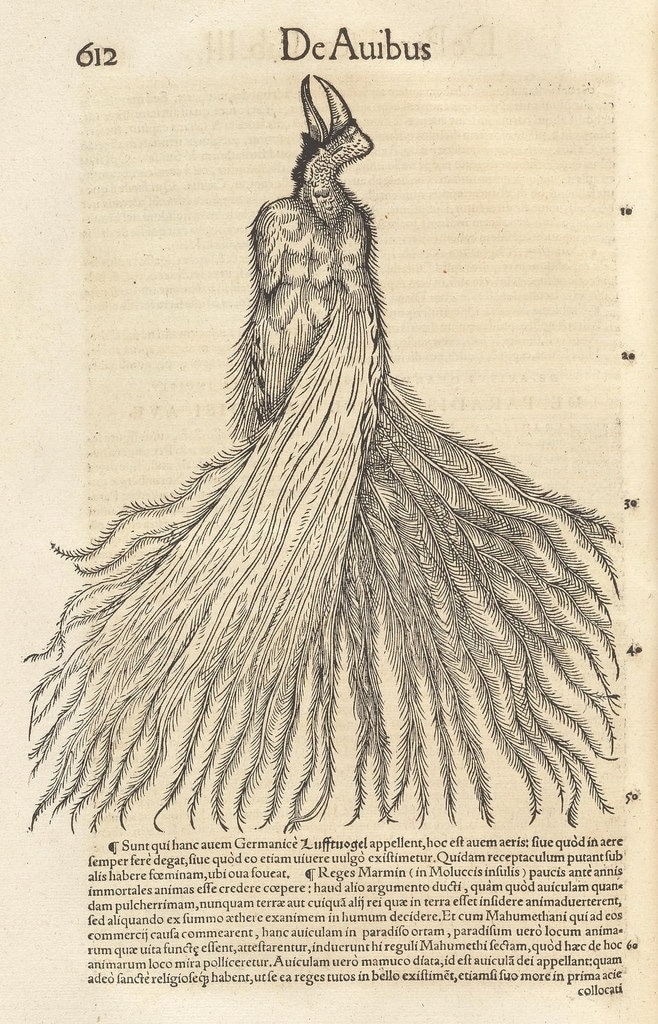
On the basis of these and other accounts, Gessner developed some marvelous ideas about the life histories of the birds. He suggested that these “Lufftvogels” (birds of the air) were effortlessly suspended by their haloes of plumes. Gessner imagined several uses for these hair-like projections, or cirri —- the naked shafts projecting beyond the rest of the feathers. He speculated that the birds might use them to hang from tree branches when they were tired. They might also be vital to the birds’ love lives: Gessner envisaged couples entwining their cirri together when mating, and as the female sat atop the male to brood her eggs amongst the clouds. He maintained that the fatigue of unending flight might in fact be taken away by the birds’ constant movement, like the perpetual movement of a clock pendulum. He argued, though, that they could not possibly live only on pure air or ether. It was far too thin to sustain anything. They were birds, after all.
Gessner often called upon correspondents to get information or images he needed. Conrad Peutinger in Augsberg sent Gessner a report and drawing of his own personal specimen to be the basis for the woodcut illustration featured in Gessner’s book. The skin in the resulting woodcut is apparently legless but lacks the hair-like projections that figured so in Gessner’s theories and were clear in other contemporary images such as Calzolari’s.
Gessner’s work was source material for many later publications, including Bolognese apothecary Ulisse Aldrovandi’s Ornithologiae hoc est de avibus historia (1599). Aldrovandi had several skins in his collection and differentiated four different species of manucodiata on this basis: Manucodiata prima, secunda, cirrata, and hippomanucodiata, each depicted in woodcuts drinking dew and floating amongst clouds. However, in his text, Aldrovandi argued that the birds could not possibly live on dew alone and conjectured that their “sturdy beaks” were very like those of woodpeckers, and “very fit to strike insects”. He also suggested that the cirri might aid “swifter flight” rather than being used in mating.
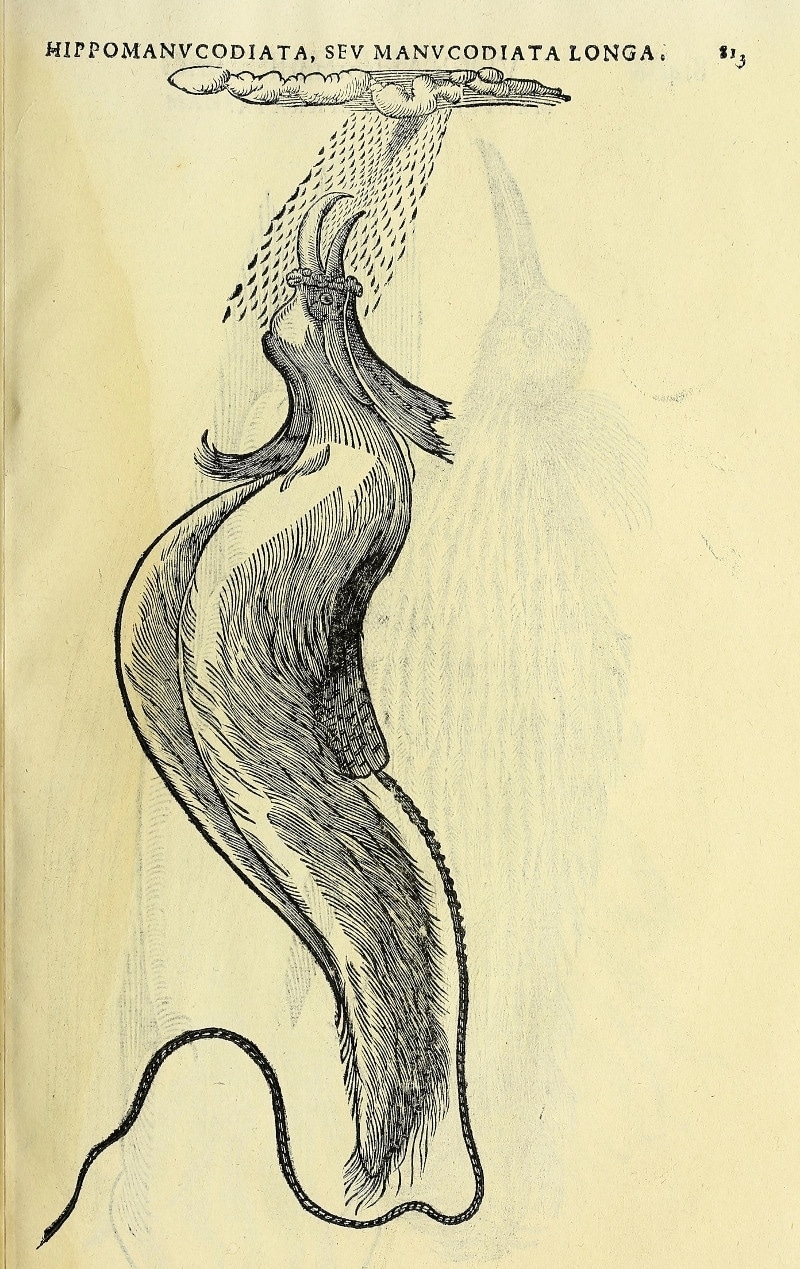
The birds certainly weren’t confined to natural histories. They were used in many books of emblems such as Joachim Camerarius’ Symbolarum et emblematum (1596), encapsulating ideas of spiritual ascension, lofty thinking, and restless, mercurial thought with their unending flight.
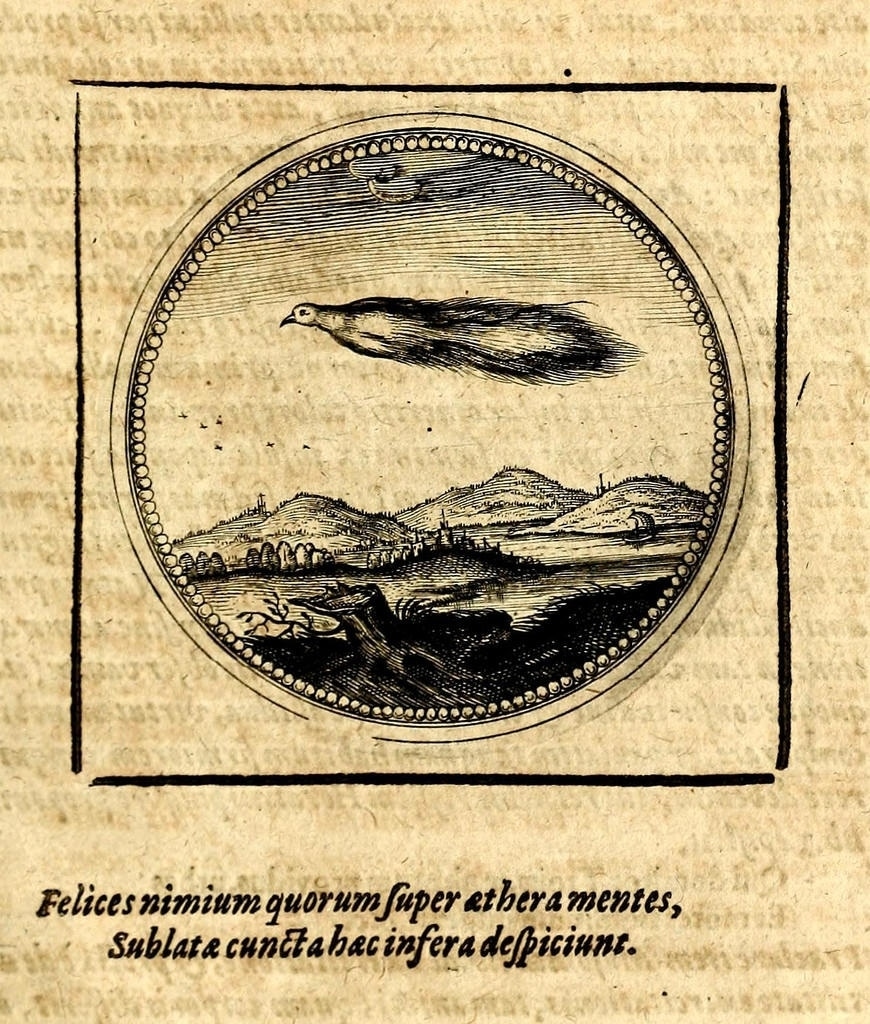
The birds, with their elaborate plumes and flighty nature, were even used as emblems of the fickle and coquettish nature of vain and richly adorned women. They also made it into the stars: Dutch astronomer Petrus Planchius enshrined the bird of paradise in a new southern constellation, Paradysvogel Apis Indica, in his 1598 celestial globe.
In art, the birds’ exotic and ascendant nature was powerfully symbolic. In Jacques Linard’s painting The Five Senses and the Four Elements (1627), for example, a bird of paradise skin is depicted as if it is flying out of the window to escape the chaos of the study. It acts as part of an alchemical allegory, symbolising the pure aerial elements: these birds were too close to the heavens to be contaminated with the exigencies of the everyday world.

In Roelandt Savery’s Landscape with Birds (1628), the birds are comet-like streaks in the sky, far above the terrestrial waterfowl and songbirds.

From the early seventeenth century some European naturalists got access to new kinds of skins that possessed legs. Several wrote long and disparaging refutations of earlier authors and their belief in legless wonders. The birds of paradise were becoming terrestrialised, just birds, no longer the ethereal angels they had been.
Yet the exoticism and moral connotations of the birds-as-angels meant that these images did not die out. Depictions of the birds were everywhere… — in paintings, religious texts, allegories, even in some newly-published retrograde natural histories. It was not only that the birds had become a geographical symbol of the wondrous East or a moral symbol of a pure existence, but that the image of monstrous legless birds fascinated people. This has not lessened today; they continue to enthrall, perhaps even more so as fabulous natural wonders than angelic impossibilities.
Natalie Lawrence recently received her PhD in history of science from the University of Cambridge. Her thesis was “Monstrous Assembly: Construting Exotic animals in the early modern Europe”, and examined the making and use of wonderful novel beasts in natural history and other publication forms from 1550-1750. Of particular focus were the angelic birds of paradise from the spice-filled east, the pangolin and armadillo from both Indies, the walrus from the frozen Arctic and the bulbous dodo of Mauritius. She is currently turning it into a book.
Pigafetta, Antonio. The First Voyage Round the World by Magellan, Translated from the Accounts of Pigafetta and other Contemporary Writers (Works Issued by the Hakluyt Society). H.E.J. Stanley (ed.). (New York: Cambridge University Press, 2010), 143.↩
Transylvanus, Maximilian. ‘A Letter from Maximilianus Transylvanus to the Most Reverend Cardinal of Salzburg…’. In Stanley, H.E.J. (ed.), The First Voyage Round the World by Magellan, Translated from the Accounts of Pigafetta and other Contemporary Writers, Works Issued by the Hakluyt Society. (New York: Cambridge University Press, 2010), 205-6.↩
 Pens and Needles: Reviving Book-Embroidery in Victorian England
Pens and Needles: Reviving Book-Embroidery in Victorian England
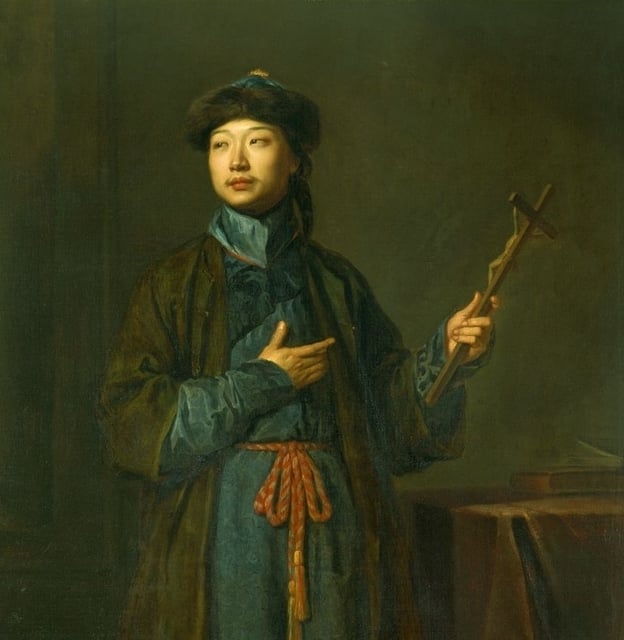 Made in Taiwan? How a Frenchman Fooled 18th-Century London
Made in Taiwan? How a Frenchman Fooled 18th-Century London